Cowick
Cuwich 1197. "Cow farm, dairy farm". Old English cu + wic
A Dictionary of English Place-Names, Oxford University Press
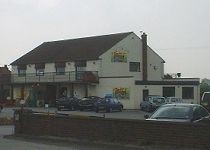

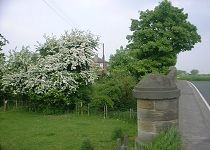
The church is modern, but traces of a moated tower said to have been built by John of Gaunt are still in the park, where there has been a hall since Tudor times. The house we see is imposing, but its great days are gone. In the park are old beeches and great elms, and a magnificent chestnut said to be one of the biggest in England. A rare possession is a maidenhair tree with broad fan-shaped leaves, one of the few growing in England, and one of the farthest north. A native of China and Japan, where it is often seen in temple gardens, it is known to have been common long before man was on the earth, fossils of it having been found embedded in the rocks.
The King's England, edited by Arthur Mee
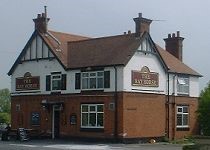

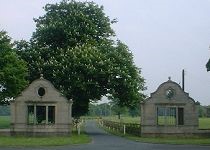
So big it was split in two, Cowick is the international headquarters of Croda Chemicals Plc. This company had its first factory in nearby Rawcliffe Bridge and now has interests all over the world. The roads from Goole, Selby and Thorne meet at Gyme Corner where there is also a great pond to go swimming and fishing in summer. The pub, the Bay Horse, is frequented by a pondering old man and his dog who sit outside in the beer garden watching the world go past.
Postcards
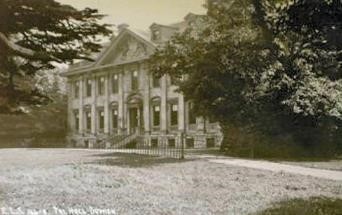
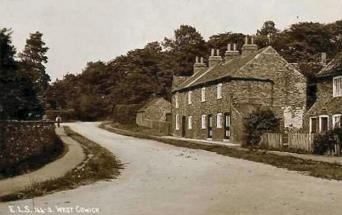
Visitor Comments
Posted by Shuffleton Streets on 20/03/2006
My dad once got done for riding his motorbike too fast round Gyme. That was before my time though, pre-War. His dad came to Goole to begin life in the metropolis c.1900. And I'm still stuck here!
Posted by Stan on 23/01/2007
I grew up in East Cowick before mains drainage had arrived! Anyone else remember the stinking open ditches we used to dare each other to jump across? I remember that the bend by the Bay Horse was a real accident spot. I also recall the old village cricket pavilion being an ancient ex double-decker tram!
Posted by Wilf on 15/11/2007
The old tram at Cowick was recovered and taken to the tram museum at Crich, near Matlock, Derbyshire for restoration, where I saw it about fifteen years ago. It wanted quite a bit more than just a coat of paint.
Posted by Alan on 23/07/2007
I am trying to trace my family tree. I believe my grandmother and great-grandmother were in service at Cowick Hall. My great-grandmother as house keeper around 1889-1901. Her name was Harriett TAYLOR and her daughter's name Louisa Taylor. I would like to hear from anyone who has information about any archives, pictures, etc. Thanks.
Posted by Claire on 23/10/2007
There was an Alice Taylor listed as a servant at Cowick Hall on the 1901 census. I think my great-great-grandfather and grandmother worked on Cowick Hall Farm at the same time
Posted by Linda on 04/09/2007
My ancestor Jane Mosley (b. 1616) married Sir Christopher Dawnay, Knight and Baron of Cowick. Janes Mosley's parents were John Mosley and Elizabeth Trigott (married 1612 in York). John Mosley's Father was a Thomas Moslaye (b. 1539, died 1624) Sheriff, Alderman and twice Lord Mayor of York in 1590 and 1602.
Posted by Paul on 07/12/2007
My grandmother was in service at Cowick Hall, Her maiden name was Threidgold and married a William Walton.
Posted by Dorothy on 03/06/2008
We think my husband's great-great-grandfather John Thompson worked on the estate as an agricultural labourer in the 1800s. Also great(x3)-grandfather Charles Thompson worked there. John Thompson lived in a cottage belonging to the estate; we think it was on Park Ave. If anyone has any info concerning the workers on the estate we would be pleased to hear. Thanks.
Posted by Corby on 23/07/2008
Whilst growing up in Goole I was always told that the pond at Gyme corner was bottomless. I always questioned this fact. If it was bottomless, did it go right through to Australia? For years I have thought about this fact and when I visited Goole on numerous occasions. With my family they would always comment "there's the bottomless pond dad".
Last month my eldest son, now 47 visited Cowick on business from here in Southampton. He called me to tell me that they had filled in the bottomless pond. I know that many other kids had been told this yarn. I wonder where it originated?
Posted by Robert on 25/07/2008
Just to confirm Corby's memory, yes we were told it was bottomless too.
Posted by Fiona on 10/10/2008
I was also told this story and apparently the road curved round it at such a sharp angle as they believed that it was bottomless.
Someone told me that a coach and horses disappeared into the pond without trace. I can vaguely remember some tests being done on it in the 1970s that proved it wasn't so, but there was a very deep layer of silt. Is it true then that it has now been filled in?
Posted by KD on 15/05/2010
As a child I was also told the story that a stage coach and horses were in the bottomless pond. Yes it's been filled in. A pink miniature lilac flowers on the site every year.
Posted by Shawn on 27/08/2010
We moved from Goole to Cowick in 1937 and I lived there until 1954. The Gyme pond was fed by a spring which eventually petered out. It was very deep and because of the depth of mud it was impossible to find the bottom. When police divers tried to recover some loot that had been dumped in there, they had to give it up as a bad job.
It was a good place to fish but to swim in it was rather dangerous because of the amount of rubbish thrown in. We used to catch eels and pike when food was on ration but they tasted a bit muddy. We would put the eels in fresh water for a couple of days to get rid of the muddy taste. The pike was eaten the same day but they were the boniest thing I'd ever eaten. The moat at the back of Cowick Hall was also playground to us.
Posted by Paul on 14/01/2016
Was past the pond at Gyme recently and can confirm it is now well filled in, overgrown and to be honest it looks a right mess! Could do with a few more lorry loads of soil to tidy it up a bit.
Posted by John on 28/05/2009
My great-uncle Benjamin Shaw (b. 1806, d. 1908) and another great-uncle Henry Shaw (b. 1833, d. 1871) bought and lived in Cowick Hall. If you have any information about them, and in particular the three stained glass windows, we would appreciate making contact.
Posted by Lynda on 07/08/2009
Henry Shaw was my great-great-grandfather.
Posted by Pauline on 21/10/2009
I am at present researching an article about the Shaws, and their cousins, the Seeds and the fruit merchants of Goole/Hessle/Hull. The Seeds/Shaws are distant relations of mine. Ann Seed (nee Naylor) wife of John Seed, was my great-great-grandmother's cousin. John Seed was Henry and Benjamin's cousin, and worked for Benjamin as his "Traveller".
I have looked into the ownership/sale of Cowick Hall in the archives and have traced the Shaw and Seed families through the censuses, parish records, etc.
I would very much appreciate any details about the family, and about Henry and Benjamin's business dealings, cargos, etc. I do know that for a while they owned a ship called Romeo, for the fruit trade. I have heard that Henry Shaw owned a cotton Mill, and haven't been able to establish where, although it states on the baptismal record of his son Thomas, at Whitechapel, Cleckheaton, that he was a "mill owner".
Posted by Jean on 12/03/2010
My great-grandfather was Henry Shaw and great-uncle was Benjamin. I can provide quite a lot of info about them, including a book on Cowick Hall and wills.
Posted by Val on 07/01/2012
We are trying also to find more information on Benjamin Shaw Seed as he bought Everthorpe Hall (behind where the prison is now) from Thomas Whittaker. We think he also bought quite a lot of surrounding land as well and three game-keeping lodges, one of which my partner's family now owns.
There seems to be little information on the history or how long Benjamin had Everthorpe Hall for. Also what is strange is we have an old map which calls an area of trees near the land we have "Shaw Plantation" which may or may not be to do with your family.
Posted by Pauline on 04/11/2013
I believe the council bought the Everthorpe estate from Mr Whittaker in 1912 and sold it on to Benjamin Shaw Seed in 1914. He lived there until his death in 1928, when the Hall passed onto his son John. Benjamin was buried in All Saints, North Cave. In 1947 John sold the estate to a Mr Baitson of Hull. Two years later it was sold to the Home Office, who made it into the prison. The lions which adorn the gates were purchased by Benjamin Shaw Seed from a grand house which was being demolished in Hull, and were later re-positioned to the front gates of the prison.
By the way, I am unsure as to whether Henry Shaw ever lived at Cowick Hall, the house was certainly up for rent as early as April 1870. I believe he died at a local farm where he was living at the time. Benjamin took over the house and lived there after his brother's death in 1871. He did remodel the house, but took out a wing which was a later addition to the property, reinstating the original exterior, which the architect intended when it was originally built.
Posted by Ian on 24/04/2014
I am interested in the Shaw/Seed connection as I am descended from Harriet Naylor (sister of John Seed's wife Ann and later John's second wife, they married in 1908). John Seed features in my family history as the benefactor who paid for Harriet's first husband's funeral in 1871. Benjamin Revell was only 27 when he died and was working for/with John in Hook at the time. He also paid for my great-grandfather (Harriet's son, Arthur Revell) to attend Ashville College in Harrogate and was named as the executor of Harriet's father's will (James Naylor, a coachman in Brighouse). John's sons, confusingly named Henry Shaw Seed and Benjamin Shaw Seed also appear as alumni in a book I have about Ashville College - a school founded in the 1870s by the Methodist Church.
Posted by Pat on 28/07/2009
Several of my ancestors also worked at Cowick Hall. My great-grandfather James Hanby remained in the service of the Dowager Lady Downe, Louisa Maria, after her husband, the Viscount, died in 1832. I'm not sure exactly what happened, but by 1851, he was with her in a household in Gloucestershire, Bowden Court, Upton St. Leonards, home of Charles Brooke Hunt and his wife Louisa. In 1841, Louisa Maria and the Hunts were in Impington in Cambridge and James Hanby was in London. The rest of James' family - father and six siblings, and some others from the village who had also worked at Cowick Hall - immigrated to northern New York State and lived at Sodus. If anyone has further information I'd be interested to know.
Posted by Deborah on 13/03/2010
I am interested in tracing the origin of my maiden name - Cowick. Does anyone know about the founding fathers of Cowick, England? Any information would be most appreciated. I have some information regarding location, etc. but nothing about who initially settled there. Thanks.
Posted by Eilona on 31/05/2014
I worked for Croda in the 1960s in the beautiful Cowick Hall. Later I lived in the village surrounding the hall. It is a lovely place. Regarding the surname Cowick and its meaning, any place name ending in Wick, is usually of Viking origin. The town of Snaith, about half a mile away was a Saxon settlement.
Posted by Cowick School on 27/06/2011
We are learning about Cowick Hall and the manor house. I have (by the way I am ten) explored down near the moat. At the moment it is very overgrown. There is a little den there which has been very well made.
Posted by BA on 01/07/2011
I was a pupil at Cowick school in the war years. Our playground was the hall grounds when it was left empty just after the prison camp closed.
Posted by Amy on 13/10/2012
My grandmother (June Robinson nee Elias) lived in Cowick Hall with her mother, father, twin brother, elder sister and elder brother with their nanny from about 1920 to around 1950 or maybe slightly later. She had servants and house staff and she remembered them dearly. We have a large etching of the house drawn at around 1940.
If anybody has any information about people who might have worked there at the time my granny lived there or if you were friends/neighbours then please get in touch as my granny's life was fascinating and I am trying to piece it all together. Thanks.
Posted by Sally on 18/10/2012
My grandmother Alice Mary Ranby (spelled Ramby in census) was a maid there in the 1911 census. I was told by older family members that when she married my grandfather John Robert Petch they both worked there. She was head housekeeper and him butler and/or chauffeur. I am still trying to find conformation of this.
Posted by Fiona on 24/10/2012
Does anyone know if the Maidenhair (Ginko Biloba) tree is still at Cowick Hall? Thanks.
Posted by David on 11/01/2016
I remember being taken to Cowick Hall at a young age 1939/early-1940s. The occupants were George and Esmie Hardy (farmer) and were friends of my parents.
Posted by Paul on 07/09/2016
My grandparents (on my mother's side) were gate keepers at East Cowick level crossing and lived in the house alongside that was provided. They were evacuated by train during the floods in the 1950s and returned to quite a mess! My mother, who grew up in the gate keeper's cottage, still lives in East Cowick less than a few hundred meters from the now disappeared cottage somewhere under the undergrowth.
Back to Table of Contents
feedback@goole-on-the-web.org.uk